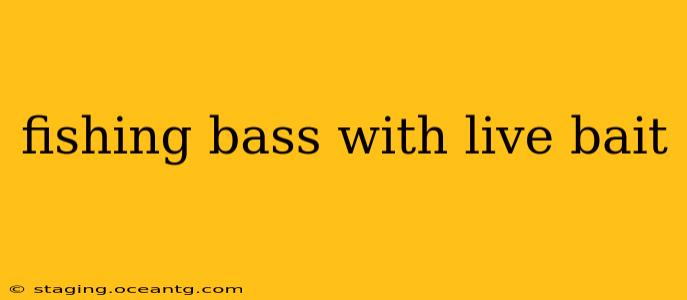Bass fishing with live bait is a classic and highly effective technique, favored by anglers for its natural presentation and enticing action. This method allows you to target bass in a variety of conditions and locations, offering a rewarding experience for both beginners and seasoned fishermen. This guide will delve into the intricacies of bass fishing with live bait, covering everything from choosing the right bait to mastering effective fishing techniques.
What are the best live baits for bass?
The best live bait for bass depends on several factors, including the time of year, water temperature, and the type of bass you're targeting. However, some consistently productive options include:
- Minnows: These are a staple in bass fishing. Smaller minnows are effective for smaller bass, while larger ones can attract trophy-sized fish. Their natural swimming action is irresistible to bass.
- Shiners: Shiners are another excellent choice, known for their durability and ability to withstand being hooked. Their silvery flash makes them highly visible in the water.
- Crawfish (Crayfish): Crawfish are particularly effective in areas with rocky bottoms or vegetation, mimicking a natural food source for bass. They are best used in slower-moving water.
- Worms: Earthworms, nightcrawlers, and other worms can be incredibly effective, especially in murky water or during low-light conditions. Their wriggling motion attracts bass' attention.
What is the best way to rig live bait for bass fishing?
Proper rigging is critical for maximizing the effectiveness of your live bait. Here are a few common and highly effective methods:
- Texas Rig: A simple and effective method, particularly for worms and crawfish. This involves using a hook with a weightless bullet sinker or small weight positioned above the hook. The weight helps in casting and allows the bait to move naturally.
- Carolina Rig: This rig is ideal for covering more water. It utilizes a weight (usually a bullet weight) on the line, followed by a swivel, then a leader with a hook. The bait is free to move naturally behind the weight.
- Simple Hook Rig: For minnows and shiners, a simple hook is often sufficient. Hook the bait through the lips or dorsal fin, ensuring it remains alive and active.
What are some effective techniques for fishing bass with live bait?
Effective techniques go beyond just selecting the bait and rigging it; understanding bass behavior is crucial.
- Targeting Structure: Bass often hold near structure such as submerged logs, rocks, weed beds, and docks. Concentrate your efforts around these areas.
- Varying Retrieval: Don't just cast and retrieve. Experiment with different retrieves—slow and steady, fast and erratic—to see what works best in the current conditions.
- Using Scent: Enhance your bait's attractiveness by adding scent. Commercial bass attractants can be effective.
- Fishing Depth: Vary your fishing depth by using different weights or adjusting your line length.
What are some tips for keeping live bait alive?
Keeping your live bait alive and active throughout your fishing trip is crucial for success.
- Use an Aerated Bait Bucket: An aerated bait bucket is essential to keep your bait fresh and lively. The aeration ensures that the water remains oxygenated, preventing the bait from suffocating.
- Keep Bait Cool: Keep the bait bucket in the shade to prevent the water from getting too warm. A cooler with ice can be helpful.
- Change Water Regularly: Replace some of the water in the bait bucket periodically to remove waste and maintain water quality.
What is the best time of day to fish for bass with live bait?
Bass are most active during dawn and dusk, when they are feeding actively. These periods usually offer the best fishing opportunities. However, bass can be caught at other times of day, especially in cloudy conditions or during periods of reduced light.
What size hooks should I use for live bait fishing?
Hook size selection depends on the size of the bait and the size of bass you are targeting. Use a hook that is large enough to secure the bait but not so large that it overwhelms it. Experimentation is key to finding the ideal size for your situation.
This comprehensive guide should help you become more successful at bass fishing with live bait. Remember that practice and patience are key to mastering this technique. Happy fishing!
